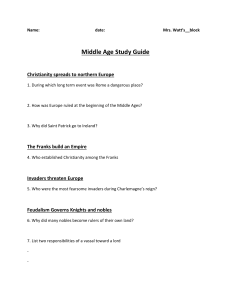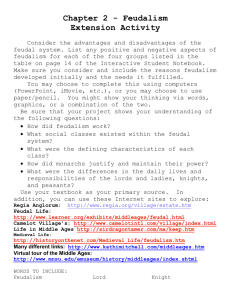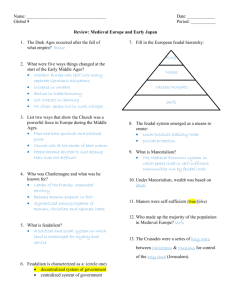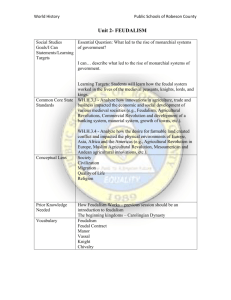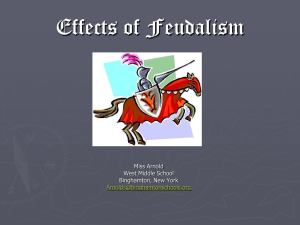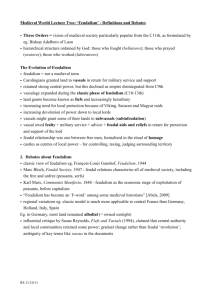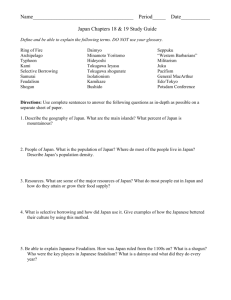How feudalism hinders community transformation and economic
advertisement
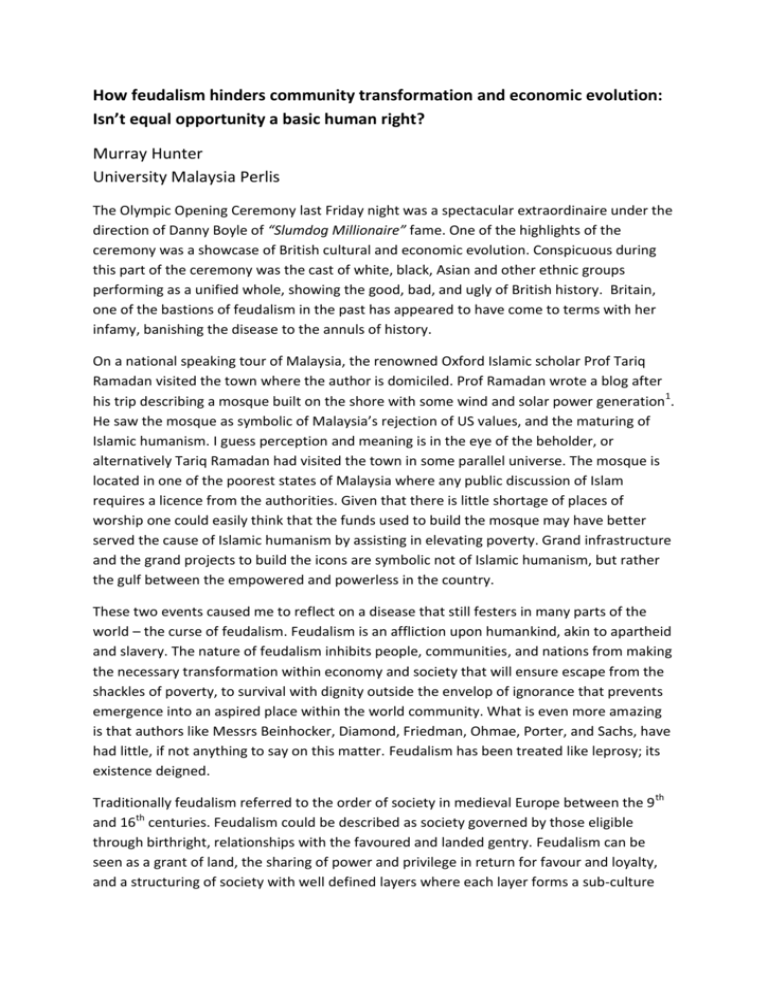
How feudalism hinders community transformation and economic evolution: Isn’t equal opportunity a basic human right? Murray Hunter University Malaysia Perlis The Olympic Opening Ceremony last Friday night was a spectacular extraordinaire under the direction of Danny Boyle of “Slumdog Millionaire” fame. One of the highlights of the ceremony was a showcase of British cultural and economic evolution. Conspicuous during this part of the ceremony was the cast of white, black, Asian and other ethnic groups performing as a unified whole, showing the good, bad, and ugly of British history. Britain, one of the bastions of feudalism in the past has appeared to have come to terms with her infamy, banishing the disease to the annuls of history. On a national speaking tour of Malaysia, the renowned Oxford Islamic scholar Prof Tariq Ramadan visited the town where the author is domiciled. Prof Ramadan wrote a blog after his trip describing a mosque built on the shore with some wind and solar power generation1. He saw the mosque as symbolic of Malaysia’s rejection of US values, and the maturing of Islamic humanism. I guess perception and meaning is in the eye of the beholder, or alternatively Tariq Ramadan had visited the town in some parallel universe. The mosque is located in one of the poorest states of Malaysia where any public discussion of Islam requires a licence from the authorities. Given that there is little shortage of places of worship one could easily think that the funds used to build the mosque may have better served the cause of Islamic humanism by assisting in elevating poverty. Grand infrastructure and the grand projects to build the icons are symbolic not of Islamic humanism, but rather the gulf between the empowered and powerless in the country. These two events caused me to reflect on a disease that still festers in many parts of the world – the curse of feudalism. Feudalism is an affliction upon humankind, akin to apartheid and slavery. The nature of feudalism inhibits people, communities, and nations from making the necessary transformation within economy and society that will ensure escape from the shackles of poverty, to survival with dignity outside the envelop of ignorance that prevents emergence into an aspired place within the world community. What is even more amazing is that authors like Messrs Beinhocker, Diamond, Friedman, Ohmae, Porter, and Sachs, have had little, if not anything to say on this matter. Feudalism has been treated like leprosy; its existence deigned. Traditionally feudalism referred to the order of society in medieval Europe between the 9 th and 16th centuries. Feudalism could be described as society governed by those eligible through birthright, relationships with the favoured and landed gentry. Feudalism can be seen as a grant of land, the sharing of power and privilege in return for favour and loyalty, and a structuring of society with well defined layers where each layer forms a sub-culture with different sets of values, beliefs, assumptions, and aspirations. Economic organization will also follow this hierarchical order where wealth will be concentrated within the upper echelons of society. There are normally very few vertical movements of people up and down the hierarchy. The basis of power is through land, capital, military, or political control, and these arrangements are hereditary and within selected families from generation to generation. Through analogy, the concept of feudalism extended to Shogunate Japan, parts of Africa, the kingdoms of the Middle East, South Asia, Latin America, South America, and to the “Malay” Archipelago (Nusantara). Although there was a movement to sponge the term in the 1970s’2; unlike the eradication of polio, the causes and symptoms of feudalism didn’t disappear. Feudalism in various forms still exists in one form or another, and its best to call a spade, a spade. The conceptual nature of feudalism can be seen to exist within three layers. The first layer consists of the institutions and associated mechanisms of the “rule of law”. Due to wide variations across the world, feudalism across this layer is difficult to precisely describe. However it isn’t so important whether the power base of institutions is based on divinity, theocracy, royal peerage, military authority, or civilian rule, some, if not many characteristics are very similar. One of the most important characteristics is that entry and membership of institutions is based on some form of privilege. Position, authority, and promotion usually involve some form of nepotism. Very strong power-distance relationships help to maintain an unquestioned authority within these institutions. Dealings with outside parties and stakeholders are usually undertaken through chosen and selected parties that are formally or informally linked to the leadership of the institution. Many of these institutions utilize the dogma they develop as means that cannot be questioned without some form of fear by the general population with covert or overt threats of punishment by the authorities. Under such a regime the rule of law is used as an instrument of control, utilized for the interests of the power-elite. Institutions strive for absolute power over a range of strategic assets important to the economy of the country, even though the constitution may specify otherwise. This is achieved through various informal methods such as extra-legal and extrajudicial action over a long period of time that intimidates the general population3. The second layer of feudalism is the way people in society are structured. In many societies this can be very overt where even ‘titled peerages’ specify class. In one modern developing country government departments serving the public even have special rooms to serve ‘VVIPs”. Other signs may be more covert where level of education divides society into the ‘educated’ that ‘believe they know what’s best’, and the ‘undereducated’. This divide is the basis of deep seated political instability in some countries. What is perhaps most important is that potential opportunities for people to enrich their lives through entrepreneurial and business opportunities is severely limited to groups outside the ‘privileged’. The most lucrative opportunities are the sole prerogative of small groups under various guises called cronyism or nepotism, etc. Due to the formal market restrictions by licensing and control over land many countries appear to be ‘business friendly’ but are certainly not ‘market friendly’, where large businesses operate under protection as monopolies or oligopolies. This brings great inefficiency to the economy in a similar manner the ‘import replacement tariffs’ of the 1960s in many developing economies at the time. As a consequence major businesses in many South East Asian nations are in the hands of only a few dozen families. Wealth is concentrated and through their position and developed complacency, these groups tend to invest in relatively low risk rent seeking investments. Many businesses are based upon resource monopolies and large tracts of land are stripped in pursuit of large profits under the thinly veiled name of development. This is not just restricted to the large firms of the nation. Farmers with connections to local authorities are able to go into state and national forests almost unchecked and carve out as much land as they can for their activities. In such societies resources are stripped for personal benefit at a cost to the environment. This is an extremely important factor contributing to global warming that has barely been mentioned in debate, let alone acted upon. Feudal societies are a major contributor to global warming. The third layer of feudalism is the most damaging to society – mindset. In feudal like societies the elite work with the assumption that ‘we are the law’ and operate accordingly, festering an ambience of narcissism through the upper echelons of society. Perceptions, ideas, and attitudes become fixed where society settles into a complacent patterning. In contrast, rural population live in an ambience of hopelessness and resignation of the assumption that ‘this is how life is’. The only groups that have much freedom of opportunity are the urban newcomers who are able to find employment or open a micro-enterprise within the major cities and towns. Such is the evolved mindset of these types of societies; conservatism, risk adversity, egocentrality, self interest, and lack of concern about the environment become the dominant traits of people and order of things. This mindset does not discriminate between public and private sector or rural and urban groups. Society creates a massive defence mechanism to deny the signs and forces of change, leading to a very fixed national narrative. This narrative can become so fixed and ego-centric that relations with neighbouring countries often become strained with the smallest of issues. Complacency brings ineptness where institutions slowly decay as corruption and patrimonialism, the propensity to favour family and friends, rise. All institutional activities are focused upon the sole objective to support the existing power elite and protect them from domestic threats. Motivation is low and service levels in both government and the private sector is more akin to the old Eastern European countries under communist rule, rather than the vibrant growth economies around the world. Corruption becomes embedded within the culture where even the young and educated see it as the only means to advance in society, and more alarmingly – not wrong4. Society disintegrates into the lowest moral and ethical form not unlike past societies that kept slaves, where in fact this still exists today in a contemporary form. Although altruism is often espoused, in reality, little if any exists within society. In some cases feudalism became established in societies that easily accepted authority after colonial masters moved out. The new governments used feudalism as a means to both control and reap benefits for themselves. Urbanization and industrialization should normally bring enough impetuous to eradicate the forms of feudalism that exist within a nations as the basis of order and organization. Change brings pressure for transformation. Urban society begins to grow rapidly, triggered by the much higher wages offered for factory employment than can be obtained in any agricultural activities. Initially this migration is selective with the younger educated seeking urban employment but as demand for workers grows and stories about higher wages filter back to the rural areas, larger numbers of people migrate to the cities. Urban populations become consumers and increase demand for all types of food, accommodation, consumer and durable goods. They also partake in savings either voluntary or through nationally induced savings schemes developed by government through an emerging banking system. The education system is enhanced from basic systems distilling discipline to those that place more emphasis on critical and creative thinking. Growing urban development attracts new entrepreneurs whose values shift from traditional attitudes to those more in line with an urban environment of a newly developing country (see figure 1.). Those with natural abilities are quick to emerge and the socioeconomic structure of society begins changing away from its feudal base. They pick up new skills and competencies from education and employment and learn as they go along in their new businesses. Shifting Values Traditional/colonialization Developing Economy Agriculture based lifestyle Connection with extended family Subsistence orientation Rural value base Acceptance of situation Little saving Urban based lifestyle Cut off from extended family Planning orientation Changing to urban values Seek to improve situation Saving for capital Social mobility – end of feudalism New wealth – New poverty Figure 1. The shifting values that urban society brings to a developing economy. However as a developing economy experiences rapidly changing demographics, this may leave a deeply divided agrarian society and newly educated urban society. This can still be seen today in most South-East Asian countries which have become part of the source of political problems in countries like Thailand5. Developing society has some influence on agrarian society through urban residents remitting funds back to parents and families in their villages and returning to build new houses and buy consumer goods. This starts to break down traditional values and bring envy into village societies. Although economic growth is destroying traditional culture and values, a whole range of new opportunities begin to emerge with rural based urban centres developing. These new towns commercially serve their respective hinterlands with goods, basic education and health services provided by government. Newly developed infrastructure, roads, railways, communications, schools, and health centres help provide the ability of rural society to transform itself. This brings a whole new range of opportunities to those that can see the opportunity, have the resources, networks and skills to develop them. The economy is now developed into partitioned agricultural, manufacturing and service industries with many new opportunities continually developing. The processes of rural-urban migration, population growth in urban centres, and increasing education, increased consumption and saving. Rising entrepreneurship occurred through increased opportunities, catalysing increased investment and rapid economic growth. These phenomena are shown in the schematic in figure 2. Changing Demographics (Rural-urban drift) Positive geographic disposition Rapid Economic Growth Increased Investment Increased Saving Population Growth Increased Demand Increased Opportunities Increasing Education Increased Knowledge New Skills & Capabilities Learn as you go Those with natural talents emerge quickly Emerging Culture Imported Technology Figure 2. The path to rapid economic growth in a developing economy. Rising populations create momentum, which create opportunities and begin to feed off each other creating a chain in the economy and expand as other opportunities become exploited. Real estate developments, need building contractors, which need hardware suppliers, which need hardware goods manufacturers, who need workers who are paid and spend money on food, accommodation, and consumer goods. Sales operations are needed to sell the real estate and credit facilities are needed to enable people to buy the homes and properties. The development of a textile industry needs suppliers, tool manufacturers and dye manufacturers, and the development of the automobile industry needs parts manufacturers, paint manufacturers, steel suppliers, logistic transport providers, and automobile dealers. All these interactions creates and environment with a set of opportunities. This pattern of development, growth, and creation of opportunities, are in a perpetual motion. The inner city and suburban areas of cities develop certain socioeconomic characteristics in terms of the sets of needs and wants consumers have leading to its own set of interrelationships which determines what can happen and what cannot happen. There are pressures to adopt new more egalitarian business structures which sometimes challenge long existing orders. During the under-developed and early developing phases of economic development in many countries, businesses have been controlled by families of government officials and the military protected by restrictive regulation and practices that allow monopolies and oligopoly competition. Such situations would be similar to those under the Suharto regime in Indonesia and the Marcos regime in the Philippines, but also exists throughout Africa, the Middle East and Latin America. In some of the old Soviet Block countries, state capitalism was replaced by a small group of politically supported entrepreneurs in what could be called ‘oligarch capitalism’. To a lesser in some countries like Malaysia certain parts of industries are controlled by Government Linked Companies (GLCs) under another version of state capitalism. The effect of these business structures is to restrict opportunity and growth to small groups of people. One of the weapons the power elite use to prevent the above chain reaction of events is to delay or fail to build the necessary infrastructure to support this transformation. However changing demographics create trends that even the most powerful elite groups cannot hold back, often bringing great political instability. In these cases it may take some form of shock event like a political upheaval or even revolution to change the situation where a more egalitarian business society is created where more liberal business environments exist6. These reforms usually come under pressure by the people who have become educated, having the confidence to recognize opportunities and had the opportunity to travel and see other countries where the business environment is much more open. Once this change in society occurs the economy can move onto the next stage of becoming a developed economy. Figure 3. shows the transformation from a feudal to a more egalitarian business society. Feudal Business Society Government officials More Egalitarian Business Society Armed forces Example Suharto era in Indonesia or Marcos era in the Philippines Few selected families Society views its own order and hierarchies. This is a barrier to opportunity as people are locked into their own social standings Shift to much more liberal environment Fair regulatory system Highly regulated business environment Shift to much more open networks More open networks Exclusive Networks More egalitarian business environment The People Way Out Grow within your base until your powerful enough to be excepted outside your social standing, example the S.E. Asian Chinese The People Result in business opportunities for a few Some form of drastic change or political event Educational Opportunities Travel Opportunities Figure 3. The shift from a feudal to an egalitarian business society. So what are the consequences of feudalism? First of all feudalism creates rigidity based on hierarchy, power distance, custom, culture, and social expectations. This embeds static practices within a society that leads to higher transaction costs and thus inefficiency 7. Any comparative advantage a nation may have can be very quickly lost through this rigidity. These embedded informal rules, status rights, norms, and beliefs impede change, which is needed in an economy that is undergoing structural change and growth. This prevents a factor based economy moving onto becoming and innovation based economy. Patrimonial practices slowly lead to economic decline, at least relative to other nations which may lead to political instability and challenge of the status quo. This economic decay is in contrast to other countries that are trying to strengthen the rule of law and transparency. Many third world governments venturing into state owned enterprises to assist in economic development are only transferring the ‘old values and practices’ into these new organizations which are doomed to inefficiency from the start. State owned enterprises instead of opening up and developing the economy further take away entrepreneurial opportunities from private citizens and thus instead of enhancing growth, just redistribute existing wealth to privileged groups8. Business in the hands of such a few within the ‘privileged class’ leads to other afflictions like groupthink that lead to consideration of few alternatives and poor decision making9. Other practices like closed tenders just enhance uncompetitiveness and raise transaction costs. Today’s international markets require innovation, particularly in developing supply and value chains. Rigid management and rent seeking industry structures based on a static outlook of society, particularly where government policy has supported this status quo greatly hinders the ability to be creative and compete internationally. In the world today there are many resource rich countries that survive on resource based exports which is hiding the underlying long term problems of the country’s lack of comparative advantage. This prevents transformation, prevents the creation of comparative advantage in anything, except for resource based monopolies and rent seeking activities. Even if drastic political change occurs, the accumulated wealth, networks, and capital, along with the inefficient institutions left behind maintain a form of neo-feudalism that cannot be easily broken up. The inertia and vested interests of what has gone on for many years prevents dynamic change. As a consequence much of a country’s population is deprived of the right to pursue basic opportunities where they are limited to a micro and SME nature. Richard Florida postulates that technology, tolerance, and talent are prerequisites to creativity and innovation, the basis that enables the transformation of an economy10. Feudalistic societies tend to be poorly endowed with technology and more importantly are unable to learn to be innovative from the infusion of new technologies. New technologies are most often applied blindly without adaptation to specific conditions within the receiving country. As many feudal societies are based on some form of dogma, tolerance for alternative views is not usually acceptable and thus original thinking and creativity is greatly hindered. To this we must add market openness to enable the other factors to flourish. Otherwise an exodus of talent from the country or ‘brain-drain’ may occur when there are any missing elements described above. Any country that seeks to find its place of prosperous contentment within the world must transform from a feudalscape to an innoscape. The capital accumulation cycle must be made to work in a way that creates real value. This economic model must comprise of equitable market regulation, strong corporate governance, sound philosophies of risk allocation, undertake banking reform, enable fair, equitable, and responsible market regulation, create prudent fiscal and monetary policy, and most importantly of all eliminate the ability of the people to use speculation as a source of wealth. As a final point in this discussion, the equality of opportunity is a basic human right. People may not be poor because they have been left behind the rest of the world, as the Sachs hypothesis would make us believe11. They may be poor because of the social and economic structures they live within. Feudalism is like a fence that keeps people away from the lush pastures of opportunity. Therefore it is disappointing that the Millennium Development Goals did not more explicitly target feudalism as a cause and preserver of poverty and devise specific strategies to eradicate it. Many meetings on development around the world have repeatedly echoed this to little avail12. The risk is that the elements of feudalism that exist around the world will be largely ignored as they are too politically difficult to tackle. The Millennium Development Goals may just tackle the symptoms rather than the actual structural causes of poverty. 1 http://www.abc.net.au/religion/articles/2012/07/25/3553156.htm Brown, E., A., R., (1974), The Tyranny of a construct: Feudalism and Historians of Medieval Europe, American Historical Review, Vol. 79, No. 4., pp. 1063-1068. 3 According to Francis Fukuyama’s hypothesis, lack of the rule of law and accountability allows a government to become easily despotic. Fukuyama, F., (2012), The Origins of Political order: From Prehuman Times to the French Revolution, New York, Farrar, Straus and Giroux. 4 rd See: Unknown, Corruption survey revealing, The Star Online, Tuesday 3 July 2012, http://thestar.com.my/news/story.asp?file=/2012/7/3/focus/11592606&sec=focus 5 See: Profile: Thailand’s reds and yellows, BBC News, 20th April 2010, http://news.bbc.co.uk/2/hi/asiapacific/8004306.stm, accessed 20th April, 2010). 6 However even in some cases this does not change even after a revolution, i.e., the fall of the Soviet Union just replaced state capitalism with ‘oligarch capitalism’, the peoples revolution against Marcos did not dispose of ‘crony capitalism’, and the revolutions in Latin America during the 1960s and 1970s did not change the situation much. Egypt, Libya, and Tunisia are still in the balance. 7 Williamson, O., E., (1999), The Mechanisms of Governance, New York & Oxford, Oxford University Press. 8 See the current debate on this issue in Malaysia at http://malaysiatoday.net/mtcolumns/newscommentaries/50917-pkr-wants-rci-on-george-kent-saga 9 Hunter, M., (2012), Opportunity, Strategy, & Entrepreneurship: A Meta-theory, Vol. 1, New York, Nova Scientific Publishers, pp. 305-308. 10 th Florida, R. (2012), The Rise of the Creative Class – Revisited: 10 Anniversary Edition – revised and Expanded, New York, Basic Books. 11 Sachs, J., (2005), The End of Poverty: How we can make it happen in our lifetime, London, Penguin. 12 rd Misra, M, (2011), The Threatened Millennium Development Goals in India, Peace & Conflict Monitor, 3 march, http://www.monitor.upeace.org/archive.cfm?id_article=781, Islam, A. (2004), Health-Related Millennium Development Goals: Policy Challenges for Pakistan, Journal of Pakistan Medical Association, http://www.jpma.org.pk/full_article_text.php?article_id=379, Abro, H., (2011), Eliminating feudalism for an th equitable socio-economic development, Business and Financial Review, 11 January, http://jang.com.pk/thenews/jan2011-weekly/busrev-10-01-2011/p7.htm 2



